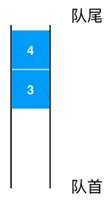数组队列
1、队列相关概念
- 队列是一种线性结构
- 相比数组,队列的操作是数组的子集
- 只能从一端(队尾)添加元素,只能从另一端(队首)取出元素
2、队列原理
队列是一种先进先出的数据结构(先到先得)
Fist In First Out(FIFO)



队首取出元素,队尾添加元素。
3、队列实现
(1)队列需要实现的方法

(2)底层使用数组实现队列

(3)编码实现队列
Queue接口定义:
public interface Queue<E> {
// 入队
void enqueue(E e);
// 出队
E dequeue();
// 获取队首元素
E getFront();
// 获取队列大小
int getSize();
// 判断队列是否为空
boolean isEmpty();
}动态数组Array定义:
public class Array<E> {
// 定义数组变量,data.length表示数组容量capacity
private E[] data;
// 定义数组中存放数据大小
private int size;
// 有参构造方法,传入数组的容量capacity构造动态数组
public Array(int capacity) {
data = (E[]) new Object[capacity];
size = 0;
}
// 无参构造方法,默认初始容量为capacity=10
public Array() {
this(10);
}
// 获取数组中元素个数
public int getSize() {
return size;
}
// 获取数组的容量
public int getCapacity() {
return data.length;
}
// 判断数组是否为空
public boolean isEmpty() {
return size == 0;
}
/* // 在数组末尾添加元素
public void addLast(E e) {
if (size == data.length)
throw new IllegalArgumentException("AddLast failed.Array is full.");
data[size] = e;
size++;
}*/
// 在数组末尾添加元素(复用add方法)
public void addLast(E e) {
add(size, e);
}
// 在数组头部添加元素(复用add方法)
public void addFirst(E e) {
add(0, e);
}
// 数组指定位置添加元素
public void add(int index, E e) {
// if (size == data.length)
// throw new IllegalArgumentException("Add failed.Array is full.");
if (index < 0 || index > size)
throw new IllegalArgumentException("Add failed. Require index >= 0 and index <= size");
if (size == data.length)
resize(2 * data.length);
for (int i = size - 1; i >= index; i--)
data[i + 1] = data[i];
data[index] = e;
size++;
}
// 获取index索引位置的元素
public E get(int index) {
if (index < 0 && index >= size) {
throw new IllegalArgumentException("Get failed.Index is illegal.");
}
return data[index];
}
// 获取第一个元素
public E getFirst() {
return this.get(0);
}
// 获取最后一个元素
public E getLast() {
return this.get(size - 1);
}
// 修改index索引位置的元素
public void set(int index, E e) {
if (index < 0 || index >= size) {
throw new IllegalArgumentException("Set failed.Index is illegal.");
}
data[index] = e;
}
// 查找数组中是否存在元素e
public boolean contains(E e) {
for (int i = 0; i < size; i++) {
if (data[i] == e) {
return true;
}
}
return false;
}
// 查找数组中元素e所在的索引,如果不存在元素e,则返回-1
public int find(E e) {
for (int i = 0; i < size; i++) {
if (data[i] == e) {
return i;
}
}
return -1;
}
// 从数组中删除index位置的元素,返回删除的元素
public E remove(int index) {
if (index < 0 || index >= size) {
throw new IllegalArgumentException("Remove failed.Index is illegal");
}
E ret = data[index];
for (int i = index + 1; i < size; i++) {
data[i - 1] = data[i];
}
size--;
// loitering objects != memory leak 手动释放内存空间
data[size] = null;
// if(size == data.length / 2) {
// resize(data.length / 2);
// }
// resize缩容优化方案(Lazy)
if (size == data.length / 4 && data.length / 2 != 0) {
resize(data.length / 2);
}
return ret;
}
// 删除数组第一个元素,返回删除的元素
public E removeFirst() {
return remove(0);
}
// 删除数组最后一个元素
public E removeLast() {
return remove(size - 1);
}
// 删除数组中指定元素e
public void removeElement(E e) {
int index = find(e);
if (index != -1) {
remove(index);
}
}
// 数组扩容
private void resize(int newCapacity) {
E[] newData = (E[]) new Object[newCapacity];
for (int i = 0; i < size; i++) {
newData[i] = data[i];
}
data = newData;
}
// 重写父类toString()方法
@Override
public String toString() {
StringBuilder sb = new StringBuilder();
sb.append(String.format("Array: size = %d , capacity = %d\n", size, data.length));
sb.append('[');
for (int i = 0; i < size; i++) {
sb.append(data[i]);
if (i != size - 1) {
sb.append(',');
}
}
sb.append(']');
return sb.toString();
}
}基于动态数组Array实现的ArrayQueue:
public class ArrayQueue<E> implements Queue {
private Array<E> array;
public ArrayQueue() {
array = new Array<>();
}
public ArrayQueue(int capacity) {
array = new Array<>(capacity);
}
@Override
public void enqueue(Object o) {
array.addLast((E) o);
}
@Override
public E dequeue() {
return array.removeFirst();
}
@Override
public Object getFront() {
return array.getFirst();
}
@Override
public int getSize() {
return array.getSize();
}
@Override
public boolean isEmpty() {
return array.isEmpty();
}
@Override
public String toString() {
StringBuilder sb = new StringBuilder();
sb.append("Queue:");
sb.append("front [");
for (int i = 0; i < array.getSize(); i++) {
sb.append(array.get(i));
if (i != array.getSize() - 1) {
sb.append(", ");
} else {
sb.append("] tail");
}
}
return sb.toString();
}
}测试队列ArrayQueue:
public class Main {
public static void main(String[] args) {
ArrayQueue<Integer> arrayQueue = new ArrayQueue<>(10);
System.out.println("入队操作开始:");
for (int i = 0; i < 10; i++) {
arrayQueue.enqueue(i);
// 入队操作
System.out.println(arrayQueue);
}
// 打印入队10个元素之后的队列
System.out.println(arrayQueue);
// 出队操作
arrayQueue.dequeue();
System.out.println("出队操作开始:");
System.out.println(arrayQueue);
}
}测试结果如下:
入队操作开始:
Queue:front [0] tail
Queue:front [0, 1] tail
Queue:front [0, 1, 2] tail
Queue:front [0, 1, 2, 3] tail
Queue:front [0, 1, 2, 3, 4] tail
Queue:front [0, 1, 2, 3, 4, 5] tail
Queue:front [0, 1, 2, 3, 4, 5, 6] tail
Queue:front [0, 1, 2, 3, 4, 5, 6, 7] tail
Queue:front [0, 1, 2, 3, 4, 5, 6, 7, 8] tail
Queue:front [0, 1, 2, 3, 4, 5, 6, 7, 8, 9] tail
Queue:front [0, 1, 2, 3, 4, 5, 6, 7, 8, 9] tail
出队操作开始:
Queue:front [1, 2, 3, 4, 5, 6, 7, 8, 9] tail
Process finished with exit code 0
4、数组队列的复杂度分析

E dequeue() 时间复杂度为O(n),因为出队底层操作是动态数组,出队操作实际上就是删除数组第一个元素,然后数组后面的元素全部往前移动一个位置,所以dequeue()时间复杂度为O(n)。
如果感兴趣的童鞋,可以观看我下一篇博客:敬请期待
























 385
385











 被折叠的 条评论
为什么被折叠?
被折叠的 条评论
为什么被折叠?








